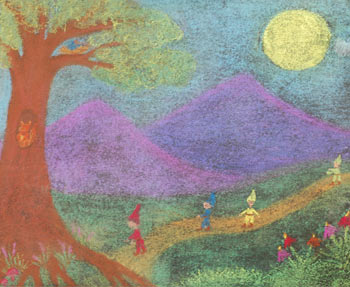Why Waldorf?
The curriculum of Waldorf schools grows out of the work of Rudolf Steiner, an Austrian scientist, philosopher, and educator who founded the first Waldorf school in Stuttgart, Germany, in 1919. While linked by Steiner’s educational philosophy, each Waldorf school is autonomous and independently run. What sets the Waldorf curriculum apart is not necessarily what is taught but how it is taught. True learning is a process of discovery that engages the whole human being. Instead of passively receiving information, Waldorf students are involved in a dynamic process of exploration, both of the world and of themselves.
Waldorf education strengthens the child to meet not only the challenges of school but also of life. To face their futures with confidence, students need to develop a capacity for clear thinking, emotional stability, intellectual flexibility, and moral values. Our objective is to help all students to blossom into young adulthood with a balanced capacity for thinking, feeling and doing, so that they are prepared with self-confidence and inner resources to accept responsibility and to take their places as creative, self-directed members of society.
The Class Teacher
The Class Teacher accepts extended responsibility for the children as their main instructor and typically stays with the same class for more than one year. One loop can take students through grade five with the same Class Teacher, with another taking the students from grade six to eight. The grade level coverage will vary, with some teachers taking their students through grade eight, or for a shorter period of time, depending on the needs of the students and school structure.
Waldorf schools recognize a basic need in children up to the age of 14 for genuine authority rooted in respect and love between the teacher and child. The class teacher strives to represent for the child a world of truth, beauty, and goodness and integrates these qualities in the presentation of the subjects taught. The fact that the class teacher must, year by year, present subjects to fit the growing consciousness and abilities of the children ensures that the teacher is constantly learning and developing, thereby modeling for the students the concept that learning is a lifelong process. The continuity of the teaching also allows the class teacher to know all the students’ unique qualities in order to plan lessons that reach and motivate each child. The relationship between teacher and child is constantly evolving and deepening. By working together over long periods of time, the class teacher and the parents can orchestrate their efforts to meet the changing needs of the child.
The Rhythm of the Day
The school day begins with the Main Lesson, a two-hour period of concentrated activity focused on a particular topic. One subject is studied for three to four weeks and then a new topic is taken up. This uninterrupted time allows the students’ intellectual understanding to merge with their experience, while also permitting the class teacher to cover a subject in depth, using a variety of approaches. The Main Lesson begins with movement and rhythmic activities such as speech, singing, and/or playing recorder followed by a review of the previous day’s work and a presentation of new material. Textbooks are not used as primary information sources. Rather, the work is presented and received in a personal exchange between the teacher and child. A recess and shorter periods in subjects such as foreign language, mathematics, and English, which require regular practice and repetition, follow the Main Lesson. Later in the day, children devote themselves to specialty subjects such as music, drama, painting, handwork, woodwork, gardening, modeling, and physical education. Thus, the rhythm of the day starts with the work that requires intellectual focus and ends with the physical activities that engage the body and hands.
Main Lesson Books
Children instinctively wish to reproduce and form what they have learned. Students work with the content of the Main Lesson to create their own books, which contain original compositions, illustrations, observations, and diagrams. Great care is taken in crafting the Main Lesson book, with attention to detail and artistic presentation. The artist in the child is nurtured; each book becomes a treasured record of the child’s own workmanship.



